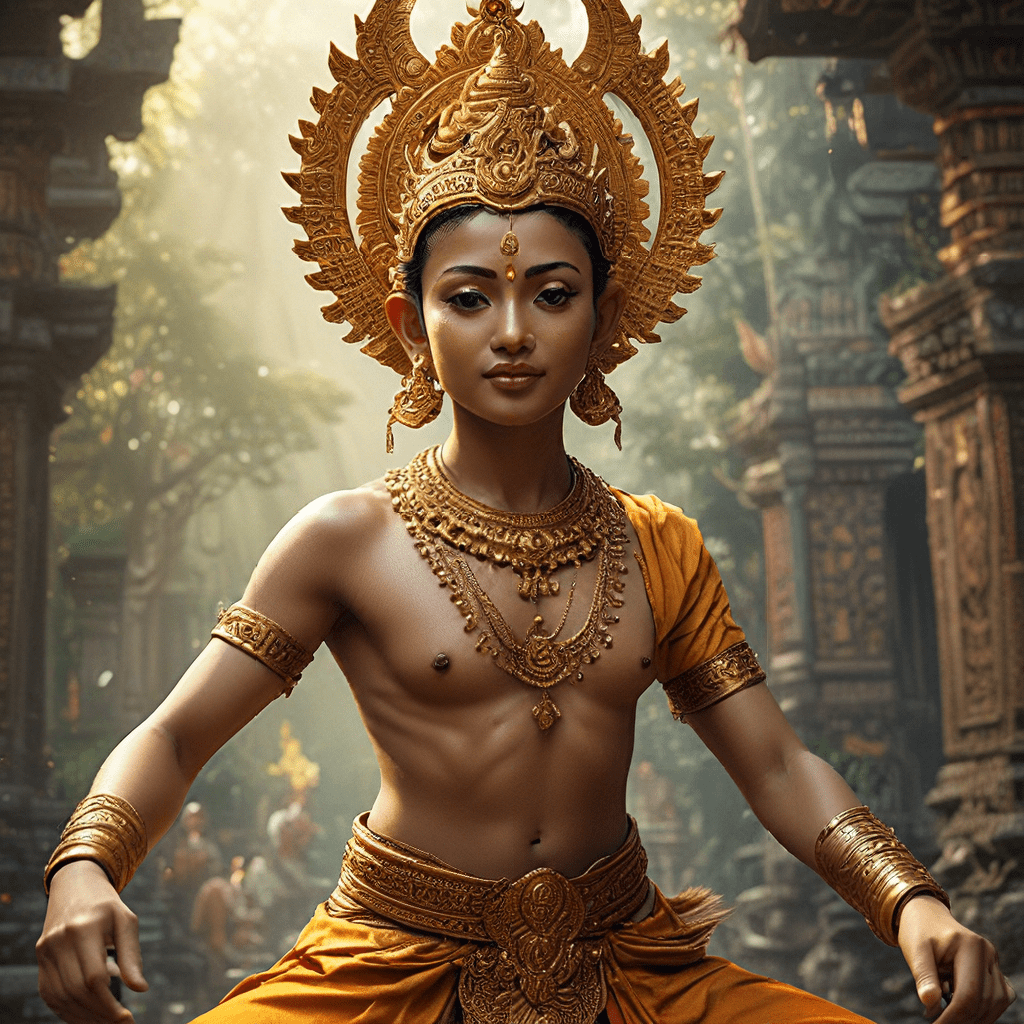The Influence of Hindu-Buddhist Mythology on Indonesian Culture: A Tapestry Woven with Myths
Indonesian culture is a rich tapestry woven with threads of history, tradition, and belief. At the heart of this vibrant fabric lies the profound influence of Hindu-Buddhist mythology, shaping the country's beliefs, practices, art, and social structures for centuries. These myths, passed down through generations, have become an integral part of Indonesian identity, offering insights into the country's cultural heritage and the enduring power of storytelling.
The Arrival of Hindu-Buddhist Influence: A Historical Context
The arrival of Hindu-Buddhist ideas in Indonesia dates back to the first centuries AD, during the flourishing of maritime trade routes in Southeast Asia. Merchants, missionaries, and travelers brought with them not only goods but also religious philosophies, rituals, and stories that resonated with the local population. These influences gradually blended with existing indigenous beliefs, creating a unique and vibrant syncretic culture.
Over time, several powerful Hindu-Buddhist kingdoms emerged in Indonesia, showcasing the influence of these faiths on political structure, religious practices, and artistic expression. Examples include the Srivijaya Empire (7th-13th centuries), which was a major center of Buddhist learning and trade, and the Majapahit Empire (13th-15th centuries), known for its Hindu cultural influence.
Key Deities and Myths: Shaping Indonesian Beliefs and Practices
Hindu-Buddhist mythology introduced a rich pantheon of gods and goddesses, each with their own unique stories, powers, and roles. These figures, often representing forces of nature, human emotions, or cosmic principles, became central to Indonesian belief systems.
Some of the most popular deities include Shiva, Vishnu, Brahma, Ganesha, and Durga from Hinduism, alongside Buddha and Bodhisattvas from Buddhism. Stories about these deities, such as the epic Ramayana and Mahabharata, were adapted and reinterpreted in Indonesian culture, weaving themselves into the fabric of everyday life. Many of these myths, like the story of the epic battle between good and evil in the Mahabharata, continue to inspire contemporary Indonesian literature, art, and social commentary.
The Influence on Literature and Performing Arts: Myths Come Alive
Indonesian literature, rich with mythical narratives, reflects the enduring influence of Hindu-Buddhist mythology. From ancient Sanskrit epics to modern-day novels, the stories and characters of these myths have been reinterpreted, adapted, and reimagined by Indonesian writers, enriching the creative landscape of the nation.
Traditional performing arts, such as shadow puppetry (wayang kulit) and dance dramas (wayang orang), also draw heavily from Hindu-Buddhist mythology. These performances, often featuring characters and stories from the Ramayana and Mahabharata, serve as a vibrant medium for transmitting cultural knowledge, values, and beliefs to subsequent generations.
The Impact on Architecture and Sculptures: Stones that Speak of Gods and Kings
The influence of Hindu-Buddhist mythology is visible in the architectural marvels and intricate sculptures that adorn Indonesia's landscape. Temples, such as the majestic Borobudur Buddhist temple and the Prambanan Hindu temple complex, stand as testaments to the artistic ingenuity and religious devotion of past civilizations.
These architectural masterpieces showcase intricate carvings and statues depicting deities, epic narratives, and scenes from daily life, offering a glimpse into the beliefs and values of the time. The sculptures, crafted with meticulous detail, immortalize the stories and figures of Hindu-Buddhist mythology, ensuring that their legacy continues to resonate through time.
Social Structure and Rituals: The Social Fabric Woven from Myth
Hindu-Buddhist mythology deeply influenced the social structure and rituals of ancient Indonesian societies. The concept of dharma, or righteous duty, played a crucial role in defining social roles and responsibilities. These roles were often linked to the deities, with the king, for instance, seen as a representative of Vishnu, embodying order and justice.
Rituals and ceremonies played a vital role in reinforcing social structures and connecting individuals to the divine. Many rituals, such as the offering of food and incense to deities, the celebration of harvest festivals, and ceremonies marking life transitions, were rooted in Hindu-Buddhist mythology and reflected the belief in divine intervention and the importance of maintaining harmony with the natural world.
The Influence on Local Customs and Traditions: Mythical Echoes in Daily Life
The influence of Hindu-Buddhist mythology extends far beyond temples and ceremonies, permeating the fabric of Indonesian daily life. Many local customs and traditions, passed down through generations, are rooted in these myths and serve as reminders of the enduring power of storytelling.
For instance, the observance of certain days of the week, influenced by the concept of the seven celestial bodies in Hindu-Buddhist cosmology, remains common in many areas. The use of traditional remedies and healing practices, often linked to the powers of deities and spirits, continues to be practiced in rural communities.
Syncretism and Transformation: A Unique Indonesian Expression of Hindu-Buddhist Belief
One of the most remarkable features of Indonesian culture is its ability to blend and transform external influences into unique expressions. As Hindu-Buddhist ideas arrived in Indonesia, they interacted with existing indigenous beliefs, leading to a process of syncretism.
This blending of traditions resulted in a unique form of Hinduism and Buddhism, incorporating elements of both faiths and adapting them to the local context. Many local deities, often representing ancestral spirits or nature spirits, were incorporated into the Hindu-Buddhist pantheon, creating a vibrant tapestry of beliefs that reflected the specific needs and concerns of the Indonesian people.
The Enduring Legacy: Mythology as a Cornerstone of Indonesian Identity
Despite the passage of time and the rise of new religions, the influence of Hindu-Buddhist mythology remains a cornerstone of Indonesian identity. These myths continue to inspire artists, writers, and musicians, serving as a wellspring of creativity and a source of inspiration for contemporary social commentary.
The stories of Ramayana and Mahabharata, once confined to temples and ancient texts, have found new life in popular culture, appearing in films, television shows, and even comic books. These adaptations, while incorporating modern elements, often retain the core themes and values of the original myths, showcasing their enduring relevance in contemporary Indonesian society.
Conclusion: A Living Legacy of Myth and Culture
The influence of Hindu-Buddhist mythology on Indonesian culture is an intricate and multifaceted tapestry. From the majestic temples that dot the landscape to the stories that resonate in daily life, these myths have shaped the nation's beliefs, practices, art, and social structures for centuries.
While the original forms of Hinduism and Buddhism may have evolved over time, the core values, stories, and characters of these myths continue to inspire and inform Indonesian identity. This enduring legacy underlines the power of storytelling and the enduring connection between human beings and the divine.
FAQ
Q: How did Hindu-Buddhist mythology influence the art of Indonesia?
A: Hindu-Buddhist mythology heavily influenced Indonesian art forms like sculpture and architecture. This is evident in the intricate carvings and statues depicting deities and scenes from epics found at temples like Borobudur and Prambanan.
Q: What are some examples of how Hindu-Buddhist mythology is present in Indonesian daily life?
A: Indonesian daily life reflects the influence of Hindu-Buddhist mythology in many ways. For example, the observation of certain days of the week, based on the seven celestial bodies, and the use of traditional remedies and healing practices linked to deities and spirits are rooted in these myths.
Q: How did the arrival of Islam in Indonesia impact the influence of Hindu-Buddhist mythology?
A: The arrival of Islam did not erase the influence of Hindu-Buddhist mythology in Indonesia. Instead, it led to a process of syncretism, where Islamic beliefs and practices blended with existing traditions. This resulted in a unique cultural blend that still incorporates elements of Hindu-Buddhist mythology.
Q: What is the significance of syncretism in Indonesian culture?
A: Syncretism is a key feature of Indonesian culture, demonstrating its ability to absorb and transform external influences. By blending different traditions, Indonesia created unique expressions of beliefs and practices, reflecting its diverse cultural heritage.
Q: How does Hindu-Buddhist mythology contribute to Indonesian identity?
A: Hindu-Buddhist mythology provides a rich framework for understanding Indonesian identity. The stories and characters of these myths offer insights into the nation's history, traditions, and values. These myths continue to inspire contemporary art, literature, and social commentary, underscoring their continuing relevance to Indonesian society.



